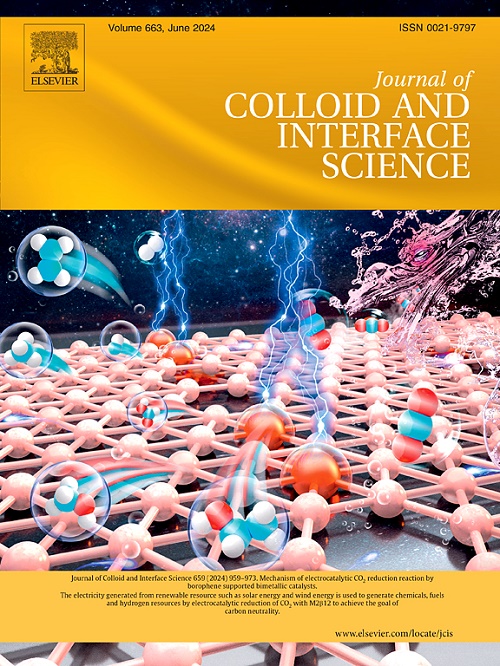聚苯乙烯光氧化降解途径中纳米禁锢诱导的位移。
IF 9.7
1区 化学
Q1 CHEMISTRY, PHYSICAL
引用次数: 0
摘要
含有高浓度纳米粒子的聚合物纳米复合材料具有优异的机械、运输和热性能。为了使其在结构应用和功能涂层中得到广泛应用,了解纳米约束和聚合物- np界面在各种环境条件下(包括长时间紫外线照射)如何影响聚合物降解是至关重要的。在这项研究中,我们研究了聚苯乙烯(PS)的光氧化降解-限制在SiO2 NP薄膜的间隙。这些纳米复合薄膜是通过毛细管上升渗透(CaRI) PS到SiO2 NP填料的间隙中,然后经过紫外线照射制备的。我们的研究表明,PS的降解过程在整个厚度上是均匀的,降解从NP间隙孔的中心开始,并向NP表面延伸。基于PS和NP表面表面能的差异,以及氧气通过受限PS的缓慢扩散,我们对这种降解机制进行了合理化。我们还证明,在给定厚度下包装更小的NP或特定NP尺寸的更厚的包装有利于光氧化降解,强调了间隙孔数量在影响降解过程中的关键作用。本文章由计算机程序翻译,如有差异,请以英文原文为准。

Nanoconfinement-induced shift in photooxidative degradation pathway of polystyrene
Polymer nanocomposites with high concentrations of nanoparticles (NPs) possess exceptional mechanical, transport, and thermal properties. To enable their widespread use in structural applications and functional coatings, it is crucial to understand how nanoconfinement and the polymer-NP interface influence polymer degradation under various environmental conditions, including prolonged UV exposure. In this study, we investigate the photooxidative degradation of polystyrene (PS)-confined in the interstices of SiO2 NP films. These nanocomposite films are prepared by the capillary rise infiltration (CaRI) of PS into interstices of SiO2 NP packings, and subsequently subjected to UV irradiation. Our investigation reveals that PS degradation progresses uniformly across the thickness, with degradation initiating from the center of the NP interstitial pores and extending towards the NP surface. We rationalize this degradation mechanism based on the disparity in the surface energies of PS and the NP surface, as well as slow oxygen diffusion through confined PS. We also demonstrate that packing smaller NPs at a given thickness or thicker packing of a specific NP size facilitates photooxidative degradation, highlighting the critical role of the number of interstitial pores in influencing degradation processes.
求助全文
通过发布文献求助,成功后即可免费获取论文全文。
去求助
来源期刊
CiteScore
16.10
自引率
7.10%
发文量
2568
审稿时长
2 months
期刊介绍:
The Journal of Colloid and Interface Science publishes original research findings on the fundamental principles of colloid and interface science, as well as innovative applications in various fields. The criteria for publication include impact, quality, novelty, and originality.
Emphasis:
The journal emphasizes fundamental scientific innovation within the following categories:
A.Colloidal Materials and Nanomaterials
B.Soft Colloidal and Self-Assembly Systems
C.Adsorption, Catalysis, and Electrochemistry
D.Interfacial Processes, Capillarity, and Wetting
E.Biomaterials and Nanomedicine
F.Energy Conversion and Storage, and Environmental Technologies

 求助内容:
求助内容: 应助结果提醒方式:
应助结果提醒方式:


